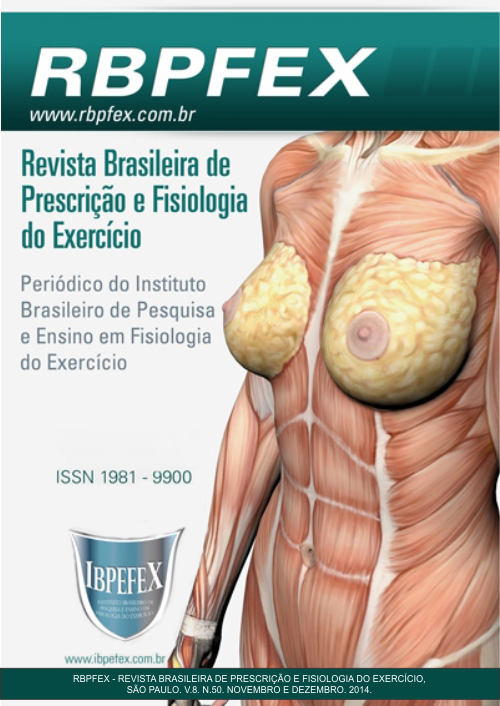Electromyography of dumbbell flyes in different tilt plans
Abstract
The weight training technical variations on the execution of the exercises, such as range of motion, lever arm, may change the muscle pattern activation, which evolve on different muscle activity. The aim of this study was to analyses the muscle of the pectoralis major clavicular head, pectoralis major sternocostal head and anterior head of deltoid muscle on fly exercises, which investigate range of motion in 30, 60, 90 degrees on horizontal plane and the incline plane (30º) in seven healthy subjects. The results did not shown any differences in the pectoralis major clavicularhead in the horizontal and incline (30º) conditions such as the pectoralis major sternocostal head. The anterior deltoid head has shown major activity in incline condition (30º) when compared with horizontal plane conditions. Statistically significant differences have been evidence of the 90 degree compare with 30 degree angle for all muscles analyzed. It was concluded that to get great muscle optimization in fly exercise, great range of motion lead to bigger muscle activity. The incline plane only leads the anterior deltoid to a greater muscle activity.
References
-Barnett, C.; Kippers, V.; Turner, P. Effects of Variations of the Bench Press Exercise on the EMG Activity of Five Shoulder Muscles. The Journal of Strength and Conditioning Research. Vol. 9. Num. 4. 1995. p. 222-227.
-Brennecke, A.; e colaboradores.Neuromuscular Activity During Bench Press Exercise Performed With andWithout Pre-Exhaustion Method. The Journal of Strength and Conditioning Research. Vol. 23. Num. 7. 2009. p. 1933-1940.
-Carpenter, C.S.C.; Novaes, J.; Batista, L.A.; A Comparação entre a puxada por trás e a puxada pela frente de acordo com a ativação eletromiográfica. Revista Educação Física. Vol. 136. 2007. p. 20-27.
-Da Silva, S.R.D.; e colaboradores. Supino Plano com Halteres: Um Estudo Eletromiográfico. Motriz. Vol. 7. Num. 1. 2001. p. 1-5.
-Delavier, F.Guia dos movimentos de musculação: abordagem anatômica. Manole. p. 50. 2000.
-Ferreira, M.I.; Büll, M.L.; Vitti, M. Electromyographic validation of basic exercises for physical conditioning programmes. IV. Analysis of the deltoid muscle (anterior portion) and pectoralis major muscle (clavicularportion) in frontal-lateral cross, dumbbells exercises.Electromyography and clinical neurophysiology. Vol. 43. Num. 2. 2003. p. 67-74.
-Glass, S.C.; Armstrong, T. Electromyographical Activity of the Pectoralis Muscle During Incline and Decline Bench Presses. The Journal of Strength and Conditioning Research. Vol. 11. Num. 3. 1997. p. 163-167.
-Hermens, H.J.; Freriks, B.; Sselhorst-Klug, C.; Rau, G. Development of recommendations for SEMG sensors and sensor placement procedures. Journal of Electromyography and Kinesiology. Vol. 10. Num. 5. 2000. p. 361-374.
-RochaJunior,V.A.; Gentil, P.; Oliveira, E.; Carmo, J. Comparação entre a atividade EMG do peitoral maior, deltóide anterior e tríceps braquial durante os exercícios supino reto e crucifixo. Revista Brasileira de Medicina no Esporte. Vol. 13. Num. 1. 2007. p. 51-54.
-Rodrigues, J.A.; Büll, M.L.; Dias, G.A.R.; Gonçalves, M.; Guazzelli, J.F. Electromyographic analysis of the pectoralis major and deltoideus anterior muscles in horizontal “flyer” exercises with loads. Electromyograph and Clinical Neurophysiology. Vol. 43. Num. 7. 2003. p. 413-419.
-Rodrigues, J.A.; Büll, M.L.; Dias, G.A.R.; Gonçalves, M.; Guazzelli, J.F. Electromyographic validation of the pectoralis major and deltoideus anteriormuscles in inverted “flying” exercises with loads. Electromyograph and Clinical Neurophysiology. Vol. 45. Num. 7-8. 2005. p. 425-432.
-Trebs, A.A.; Brandenburg, J.P.; Pitney, W.A. An electromyography analysis of 3 muscles surrounding the shoulder joint during the performance of a chest press exercise at several angles.The Journal of Strength and Conditioning Research. Vol. 24. Num. 7. 2010. p. 1925-1930.
-Signorile, J.E.; Zink, A.J.; Szwed, S.P. A comparative electromyographical investigation of muscle utilization patterns using various hand positions during the lat pull-down.The Journal of Strength and Conditioning Research., Vol. 16. Num. 4. 2002. p. 539-546.
-Sperandei, S.; Barros, M.A.; Silveira-Júnior, P.C.; Oliveira, C.G. Electromyographic analysis of three different types of lat pull-down. The Journal of Strength and Conditioning Research. Vol. 23, Num. 7, 2009. p. 2033-2038.
-Welsch, E.A.; Bird, M.; Mayhew, J.L. Electromyographic Activity of the Pectoralis Major and Anterior Deltoid Muscles During Three Upper-Body Lifts. The Journal of Strength and Conditioning Research.Vol. 19. Num. 2. 2005. p. 449-452.
Authors who publish in this journal agree to the following terms:
- Authors retain the copyright and grant the journal the right of first publication, with work simultaneously licensed under the Creative Commons Attribution License BY-NC which allows the sharing of the work with acknowledgment of the authorship of the work and initial publication in this journal.
- Authors are authorized to enter into additional contracts separately for non-exclusive distribution of the version of the work published in this journal (eg, publishing in institutional repository or book chapter), with acknowledgment of authorship and initial publication in this journal.
- Authors are allowed and encouraged to post and distribute their work online (eg, in institutional repositories or on their personal page) at any point before or during the editorial process, as this can bring about productive change as well as increase impact and impact. citation of published work (See The Effect of Free Access).






